June '08 Trip Santa Cruz IslandThe Nature Conservancy owns about
76% of Santa Cruz Island, which is restricted to no public access. Their efforts to preserve and restore the land range from native species restoration to pig eradication campaigns to support the island fox populations. Access to most of the island's coves is only possible by boat, which is how we made it into Fry's Harbor.
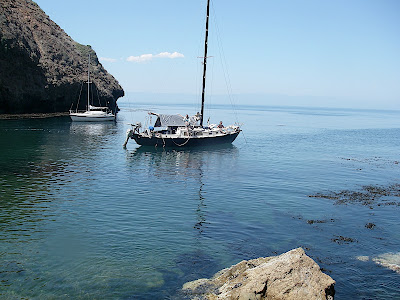
The experience of being anchored in a remote cove is unlike any other I know. The lack of civilization, the calm water, no distractions from phones, internet, and chores, lends to a near total state of relaxation. I say near total, because for the captain at least there is always an undercurrent of anxiety, which often lies unmanifested, but is ready to be triggered at the hint of any problem.
The dragging anchor is the primary possibility for stress - if the wind picks up and/or the anchor is fouled (not properly set) the rocks are awfully close by. But there is also a personal satisfaction drawn from the responsibility of smart anchoring and the edginess of being on your feet at all times.
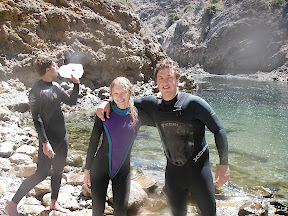
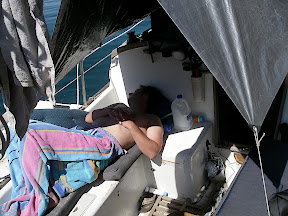
As for the crew, the total relaxation was multiplied by the heat wave that was overtaking the California coastline during this summer solstice weekend - 85 degrees on the coast, not a breath of wind even in the "Windy Lane". The water was crystal clear, not too cold (63 degrees or so), we donned our wetsuits and went diving. Swimming through the kelp beds is a show of filtered light, tunnelling through the plant material that rises 40 feet off the ocean floor; and when we are free-diving, to look up at the water surface twinkling above and look for an opening in the kelp is a veritable joy.
A note on kelp: it is the fastest growing plant at a max of 2 feet per day (in contrast to shabby performance of bamboo, corn, and kudzu, which grow up to 1 foot per day), supporting a productive ecosystem of fish and crustaceans by affording hidding spots from predators and providing plenty of food. Only because of the cold water from the upwelling of nutrients does kelp grow, so even though it's located in chilly waters with the right wetsuit and attitude the experience is well worth it.
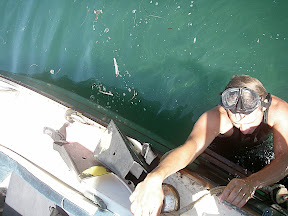
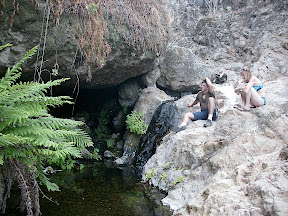
In the spirit of
Two Years Before the Mast, I recruited my willing crewmates to do some maintenance work on the boat after our leisurely morning. That book taught me two things: 1. to be thankful that I have my own boat, despite its trials and tribulations, there is nobody who will slave-drive me; and 2. that the pattern of a vessel disintegrating at sea and being repaired in the harbor need not be the case, that through diligent maintenance it can actually be more beautiful when it returns to port.
So we scrapped the hull free of barnacles for 45 minutes each, and sanded and oiled the teak trim of the toerails and handholds; and in 2 hours accomplished what would have taken 8 hours for me to do in port. All the while, we had big grins in our faces because we knew a nice dip in clean water was seconds away.
 View of the Black Pearl as I paddled to the wharf Furthest out at East Beach, but still close enough so friends would be able to check on the boat, I dropped the 33lb Bruce anchor and 250 feet of chain - which is a fair amount for 40 feet of water during the summer. In case the harbor patrol had to tow my boat (knock on wood) and drop the anchor rode overboard, I left a few buoys handy. With surfboard and waterproof satchel in hand I jumped in the water and paddled back to the wharf, much to the confusion of the fishermen at the pier.
View of the Black Pearl as I paddled to the wharf Furthest out at East Beach, but still close enough so friends would be able to check on the boat, I dropped the 33lb Bruce anchor and 250 feet of chain - which is a fair amount for 40 feet of water during the summer. In case the harbor patrol had to tow my boat (knock on wood) and drop the anchor rode overboard, I left a few buoys handy. With surfboard and waterproof satchel in hand I jumped in the water and paddled back to the wharf, much to the confusion of the fishermen at the pier.





